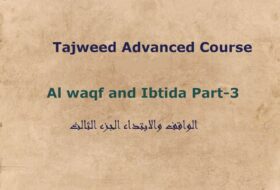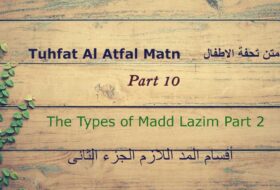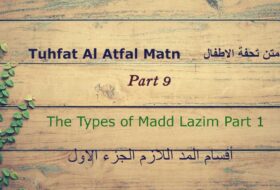The Rules of the Meem mushadadh and Meem saakinah
أحكام الميم و النون المشددتين
وَغُنَّ مِيمـاً ثَمَّ نُونـــاً شُددَّاً وَسَـمَّ كُـلاً حَـرْفَ غُنَّةٍ بَــدَا
أحكام الميم الساكنة
والميمُ إن تَسْكُنْ تَجِي قَبْلَ الهِجاَ لا ألـفٍ ليَّنَةٍ لـِذِي الحِجَــــا
أحْكـَامُهَا ثَلاثَةٌ لِمَــنْ ضَبَطْ إِخْفَاءٌ اِدْغَامٌ وَإظْـهارٌ فَقَـــطْ
فَالأَوَّلُ الإِخْفَـــاءُ عِنْدَ البَاءِ وَسَمَّهِ الشَّفْــــوِيَّ لِلقــُرَّاء
وَالثَّانِ إِدْغَــــامٌ بِمِثْلِهَا أَتَي وَسَمَّ إِدْغَامـاً صَغِيراً يَـــا فَتَي
وَالثَّالثُ الإِظهَـــارُ فِي البَقِيَّهْ مِنْ أَحْـرُفٍ وَسَمَّـــهَا شَفْوِيَّه
أحْكـَامُهَا ثَلاثَةٌ لِمَــنْ ضَبَطْ إِخْفَاءٌ اِدْغَامٌ وَإظْـهارٌ فَقَـــطْ
وَاحْذَرْ لَدَي وَاوٍ وَفَـا أَنْ تَخْتَفِي لِقُرْبِهَـا وَالاتَّحَـادِ فَاْعـــرِفِ
TEXT: 17
وَغُنَّ مِيمـاً ثَمَّ نُونـــاً شُددَّاً وَسَـمَّ كُـلاً حَـرْفَ غُنَّةٍ بَــدَا
VOCABULARY:
وَغُنَّ – make / apply ghunnah
شُددَّاً – ُwhen they (noon and meem) have a shaddah
وَسَـمَّ – name
كُـلاً – ُ ًُall / each one
كُـلاً – letter
بَــدَا – clear / apparent
TRANSLATION:
17. And apply ghunnah to meem, then the noon whenever they have a shaddah, and name each (of them; the noon and the meem) a letter of ghunnah (which is) clear.
COMMENTARY:
When the noon or the meem are mushaddad then the ghunnah in both of them should be read clearly.
Due to the ghunnah being so apparent in these letters, each one of them will be called a letter of ghunnah.
TEXT: 18
والميمُ إن تَسْكُنْ تَجِي قَبْلَ الهِجاَ لا ألـفٍ ليَّنَةٍ لـِذِي الحِجَــــا
VOCABULARY:
تَجِي – ََto come. It was originally but the hamzah at the end of the word is dropped to keep the rhyme scheme. In some prints it appears with the hamzah. Both are allowed, though preference is given to the first since most copies appear without it.
الهِجاَ – the alphabet i.e. the letters of the alphabet. The hamzah at the end has also been dropped.
لا – َnot / excluding / except
ألـفٍ ليَّنَةٍ – soft alif, referring to the alif of madd
الحِجَــــا – intellect, brains, understanding .
TRANSLATION:
18. And the mem when it has a sukon, coming before the (letters of the) alphabet, excluding the soft alif for the possessor of intellect.
COMMENTARY:
The rules applicable to the meem sakinah will be based on the letter of the alphabet that follows the meem sakinah . Therefore, before the author actually starts explaining the rules, he states that the meem sakinah can appear before all the letters of the alphabet, except the Alif.
The person who possesses a little understanding will know that two sakin letters do not come together in the Arabic language except during waqf, when it is allowed. Thus, a meem which is sakin will never be followed by an alif because the alif is always sakin.
TEXT: 19
أحْكـَامُهَا ثَلاثَةٌ لِمَــنْ ضَبَطْ إِخْفَاءٌ اِدْغَامٌ وَإظْـهارٌ فَقَـــطْ
VOCABULARY:
أحْكـَامُهَا – its rules
ثَلاثَةٌ – three
لِمَــنْ – for him
ضَبَطْ – precision
فَقَـــطْ – only
TRANSLATION:
19. Its (the Meem’s) rules are three for him (who wants) precision: ikhfa, idgham and iṭḥ-haronly.
COMMENTARY:
In this line the author mentions that there are three rules for the mim sākinah: ikhfaʾ, idgham and iṭḥ-har.
In the next line, he embarks on an explanation of these three rules .
TEXT: 20
فَالأَوَّلُ الإِخْفَـــاءُ عِنْدَ البَاءِ وَسَمَّهِ الشَّفْــــوِيَّ لِلقــُرَّاء
VOCABULARY:
وَسَمَّهِ – name it i.e. the ikhfaʾ of meem sakinah
الشَّفْــــوِيَّ – labial i.e. coming from the lips
لِلقــُرَّاء – according to the qurraʾ (reciters/readers)
TRANSLATION:
20. So the first (rule) is ikhfaʾ, (when the mīm sakinah appears) by the baʾ. And name it (this ikhfaʾ) labial according to all the qurraʾ.
COMMENTARY:
The first rule of the mīm sakinah is ikhfaʾ. It will take place if the mim sakinah comes before a ba. The ikhfaʾ of mim sakinah is called ikhfaʾ shafawi or the labial ikhfaʾ because the meem sakinah is pronounced from the lips, and the application of ikhfaʾ (concealing of the mim) will therefore also take place in the lips.
- This rule will be applied by all the qurra.
In some copies, instead of ِعِنْدَ البَاءِ comes thereِ قيل البَاءِ latter the, being mentioned by Jamzuri himself. Sheikh Muḥammad Atiq Deobandi seems to agree, citing the latter in the core text and mentioning the first in the footnote. Most copies seems to give preference to the first.
TEXT: 21
وَالثَّانِ إِدْغَــــامٌ بِمِثْلِهَا أَتَي وَسَمَّ إِدْغَامـاً صَغِيراً يَـــا فَتَي
VOCABULARY:
بِمِثْلِهَا – the same like it, its equivalent i.e. another meem
أَتَي – comes, appearsَ
إِدْغَامـاً صَغِيراً – small idghām or minor idgham
يَـــا – Oh, used when calling someone
فَتَي – young boy, lad. It refers to the student who is a beginner
TRANSLATION:
21. And the second (rule) is idghAm with its equivalent (another meem) appearing. And name it (this idghAm) idghAm ṣaghIr Oh student.
COMMENTARY:
The second rule the author explains is idgham of the meem saakinah. It wil take place when the mim sakinah is followed by another meem .
بِمِثْلِهَا The first meem is assimilated into the second mem, and is read as one meem which is mushaddad.
TEXT: 22
وَالثَّالثُ الإِظهَـــارُ فِي البَقِيَّهْ مِنْ أَحْـرُفٍ وَسَمَّـــهَا شَفْوِيَّه
VOCABULARY:
البَقِيَّهْ – remaining, left over
وَسَمَّـــهَا – name it i.e. this iṭḥ-har of mīm sakinah
شَفْوِيَّه – َlabial i.e. coming from the lips .
TRANSLATION:
22. And the third (rule) is iṭḥ-hār in the remainder of the letters. And name it (this iṭḥ-har) labial.
COMMENTARY:
The third and last rule explained to us by the author is iṭḥ-har. It will take place when the meem sakinah is followed by any of the remaining letters (excluding the bāaʾ of ikhfaʾ, the mīm of idgham and the alif) of the alphabet. The meem will then be read with iṭḥhar i.e. clearly without any extra nasal pull.
This iṭḥ-har is called iṭḥ-har shafawi or the labial iṭḥ-har because the meem sakinah is pronounced from the lips, and the application of iṭḥ-har (reading of the mim clearly) will therefore also take place in the lips.
TEXT: 23
وَاحْذَرْ لَدَي وَاوٍ وَفَـا أَنْ تَخْتَفِي لِقُرْبِهَـا وَالاتَّحَـادِ فَاْعـــرِفِ
VOCABULARY:
وَاحْذَرْ – beware, be careful
لَدَي – by, at
تَخْتَفِي – ْhide, conceal to
لِقُرْبِهَـا – due to its nearness
وَالاتَّحَـادِ – oneness, unity, unison, agreement
فَاْعـــرِفِ – so know, be aware, take head (of this)
TRANSLATION:
23. Be careful at a waw and a fa that it (the meem) be hidden due to its nearness (to the faʾ in makhraj) and unity (in makhraj with the waw), so know this.
COMMENTARY:
After the explanation all three rules of meem sakinah, the author mentions that heed should be taken when the mīm sakinah is followed by a fāʾ or a wāw. If mīm sākinah is followed by either of these two letters, iṭḥ-har will take place i.e.
the mīm should be read clearly. However, due to the Meem being so close to the faʾ in makhraj, and sharing the same makhraj with waw, the application of iṭḥ-har tends to be incomplete; thus rendering the meem to be somewhat hidden, instead of clear. Extra care should therefore be taken that iṭḥ-haar be made properly when meem sakinah is followed by a faʾ or a waw.
Jamzuri mentions that it would be correct to read the faʾ in the text with a tanween also i.e. وَفَـا
appears in some texts as وَالاتَّحَـادِ with a tanween and a lam maksurah instead of lam al-taʿrif. The meaning in both cases remains unchanged.
Tuhfat Al-atfal matn part-5 متن تحفة الاطفال
learning-quran-online
online-arabic-course














